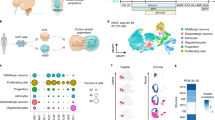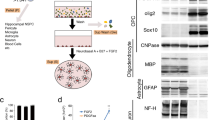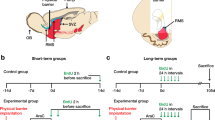Abstract
It is well documented that target cells can regulate the morphological and biochemical development of peripheral afferent neurones1,2, but little is known about the existence of such regulatory mechanisms in the central nervous system. We therefore investigated previously the influence of striatal target cells on the maturation in vitro of nigrostriatal dopaminergic neurones, which survive in culture for more than 5 weeks, develop dense arborizations and both take up 3H-dopamine(DA) by a high-affinity specific process and synthesize 3H-DA from 3H-tyrosine3. Furthermore, depolarization by potassium or veratridine stimulates the release of DA through a calcium-dependent mechanism and tetrodotoxin prevents the veratridine-evoked release of the transmitter4. Both the number of 3H-DA uptake sites and the capacity for 3H-DA synthesis were at least doubled when the neurones were cultured with target cells from the striatum3. To determine whether glial cells which proliferate in serum-complemented medium are partly responsible for the maturation of dopaminergic neurones and/or for the effect of striatal cells, we have now repeated the experiment using serum-free medium in which virtually pure neuronal populations can be obtained5–7. The reduction in the number of glia did not affect either the maturation of dopaminergic cells alone, or the effect of striatal cells. Autoradiographic analysis of the number of dopaminergic cells strongly suggests that the stimulatory effect is related to increased capacities of 3H-DA uptake and synthesis per dopaminergic neurone.
This is a preview of subscription content, access via your institution
Access options
Subscribe to this journal
Receive 51 print issues and online access
$199.00 per year
only $3.90 per issue
Buy this article
- Purchase on Springer Link
- Instant access to full article PDF
Prices may be subject to local taxes which are calculated during checkout
Similar content being viewed by others
References
Black, I. B. A. Rev. Neurosci. 1, 183–214 (1978).
Patterson, P. H. A. Rev. Neurosci. 1, 1–17 (1978).
Prochiantz, A., di Porzio, U., Kato, A., Berger, B. & Glowinski, J. Proc. natn. Acad. Sci. U.S.A. 76, 5387–5391 (1979).
Daguet, M. C., di Porzio, U., Prochiantz, A., Kato, A. & Glowinski, J. Brain Res. 191, 564–568 (1980).
Barnes, D. & Sato, G. Analyt. Biochem. 102, 255–302 (1980).
Bottenstein, J. E., Skaper, S. D., Varon, S. S. & Sato, G. H. Expl Cell Res. 125, 183–190 (1980).
Faivre-Bauman, A., Rosenbaum, E., Puymirat, J., Grousselle, D. & Tixier-Vidal, A. Devl Neurosci. (in the press).
Labourdette, G., Roussel, G., Ghandour, N. S. & Nussbaum, J. L. Brain Res. 179, 199–203 (1979).
Author information
Authors and Affiliations
Rights and permissions
About this article
Cite this article
di Porzio, U., Daguet, MC., Glowinski, J. et al. Effect of striatal cells on in vitro maturation of mesencephalic dopaminergic neurones grown in serum-free conditions. Nature 288, 370–373 (1980). https://doi.org/10.1038/288370a0
Received:
Accepted:
Issue Date:
DOI: https://doi.org/10.1038/288370a0
This article is cited by
-
A pH-responsive nanoparticle targets the neurokinin 1 receptor in endosomes to prevent chronic pain
Nature Nanotechnology (2019)
-
Alleviation by GABAB Receptors of Neurotoxicity Mediated by Mitochondrial Permeability Transition Pore in Cultured Murine Cortical Neurons Exposed to N-Methyl-d-aspartate
Neurochemical Research (2018)
-
Super-resolution microscopy reveals functional organization of dopamine transporters into cholesterol and neuronal activity-dependent nanodomains
Nature Communications (2017)
-
Effects of Mecp2 loss of function in embryonic cortical neurons: a bioinformatics strategy to sort out non-neuronal cells variability from transcriptome profiling
BMC Bioinformatics (2016)
-
Extracellular Superoxide Dismutase in Cultured Astrocytes: Decrease in Cell-Surface Activity and Increase in Medium Activity by Lipopolysaccharide-Stimulation
Neurochemical Research (2012)
Comments
By submitting a comment you agree to abide by our Terms and Community Guidelines. If you find something abusive or that does not comply with our terms or guidelines please flag it as inappropriate.



